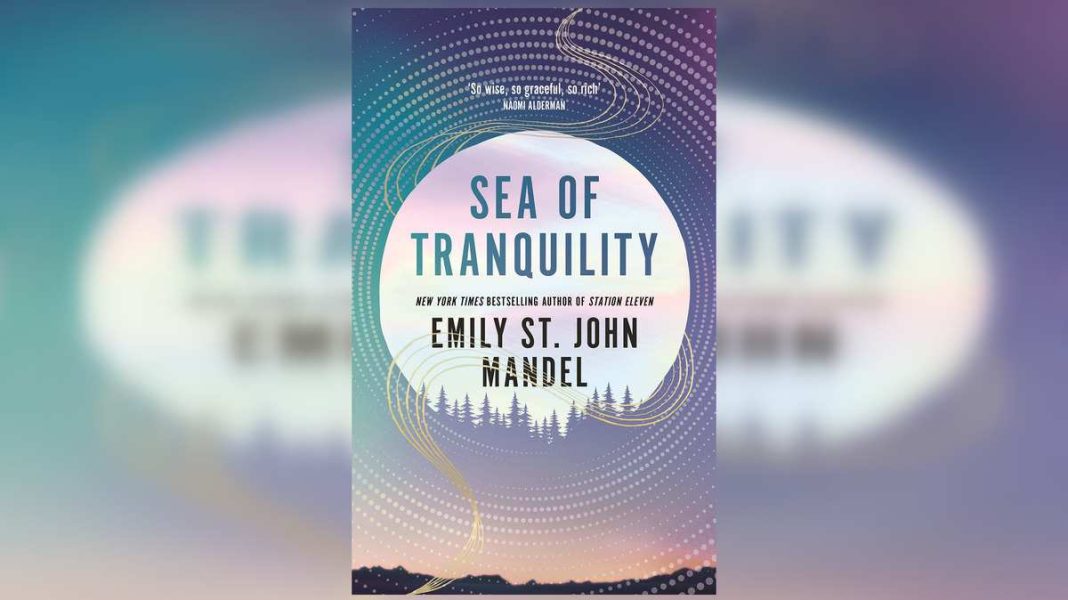A book that promises a sea full of tranquility holds immense appeal in these chaotic times. The blurb promises speculative fiction—a heady amalgam of sci-fi, the nuances of time travel, and deep philosophical questions. But Sea of Tranquility by Emily St. John Mandel goes far beyond its synopsis to deliver a uniquely human experience full of meaning, companionship, and beauty in the present. This celebrated author previously wrote the best-selling books “Station Eleven” and “The Glass Hotel.” Her latest book was longlisted in the Goodreads Best Fiction category this year. It loosely centers on the Simulation Hypothesis, first proposed by the Swedish philosopher Nick Bostrom and popularized by one of the most acclaimed sci-fi films, “The Matrix.” Do all of us live in a simulation? Is reality what it seems, or is it programmed, like scheduled rainfalls in the moon colonies in the novel? But the million-dollar question is: does it matter either way?
What Happens In ‘Sea Of Tranquility’?
The novel sets sail in 1912 with Edwin St. John St. Andrew, a privileged Englishman not in line for inheritance, charting the waters of the Atlantic. Things quickly get going when Edwin makes his way through a maple tree overgrowth in the forest. Suddenly, everything is a blur, and he hears an impenetrable symphony: a violin, a whoosh, and the sounds of a train station. Roberts, the new priest he meets, turns out to be a fake, and Edwin is left unhinged. We shift gears to 2020, where we meet Mirella Kessler at a music concert. The musician is the brother of her long-lost friend, Vincent. Old video footage reveals that Vincent had a similar experience at the maple tree. She runs into Gaspery, an investigator who quizzes the musician about the curious forest footage. But who is this man? He resembles a gunman she met on an overpass as a kid. He had addressed her as Mirella then—or had she hallucinated?
The next pivotal character is Olive, a bestselling author in the year 2203. She lives in a moon colony but travels to Earth for book tours—experiences that fill her with working-mom anxiety. Her latest book, Marienbad, has a character named Gaspery Jacques. The curious coincidence is pointed out to her when the namesake arrives as an interviewer. We wonder if Olive is on a different tour in a parallel universe, confused due to sleep deprivation and the profound loneliness of corporate hotels. The final segment deals with Gaspery and his nerdy sister Zoey, who works at the unimaginatively named Time Institute. Then, the many threads start unraveling, and the quests through time become lucid.
Occasionally, keeping track of the many characters and timelines feels disorienting. Will the characters come together? Someone even asks Olive this at a reading, hinting at the overrun of people and plots in this paperback. However, the chapter division is neat – divided by timelines with a central focus on only one or two characters at a time. That and the straightforward, omniscient narration make it immensely readable. By the time the denouement arrives, the focus is primarily on the Gaspery of the past, the present, and the future. It is an oddly comforting place. Works of speculative fiction use the future to understand the present. Mandel also expertly combines the past but brings all the sections to satisfactory conclusions.
‘Sea Of Tranquility’ Ending Explained – What Caused The Corruption In The Timeline?
Gaspery-Jacques Roberts sets out to investigate the glitch, the inexplicable something that caused Edwin to hear the violins and the whoosh of an airplane in the maple tree clearing. He continues his investigation through the years on a traveling contract with the Time Institute, interviewing Mirella, Olive, and Alan Sami, the violinist. But it turns out that Gaspery himself was the corruptor or at least the cause of it. He had interviewed the violinist, who was himself from a different era and was rendered beyond recognition with technology to defeat facial and iris recognition. The fact that two Gasperys could exist at the same time triggered a glitch. The repercussions extended through the years, back and forth, changing many lives in their wake.
During his travels, Gaspery finds it impossible to resist altering the timeline. Would it be humane to let people die when just a word from you could save them? He visits Edwin, now an invalid war hero struggling with PTSD, and discloses the reality of the maple tree incident. It helps him grasp a shred of sanity, saving him from getting admitted to an insane asylum. He advises Olive to go home immediately, thus protecting her from contracting a deadly virus that wiped out thousands. The ending Mandel chose almost anticlimactic. The problem of an underwhelming ending is familiar in her works. Station Eleven and The Glass Hotel also had closures that fell short of groundbreaking. But that is beside the point. Endings—deaths—are rarely climactic; they are only plot points. What matters, Mandel suggests, is the meaning we can find before doom.
Writing In The Wake Of A Pandemic
Sea of Tranquility is not about COVID-19. But it is a piece of post-pandemic literature, speculating on what it will take to end the world as we know it and what we stand to lose. It is as much about the coronavirus as Ebola or the Spanish flu, trying to understand our obsession with the end. At one point, Olive discusses this during a conference about Marienbad. Does the disparity make us want to end the world and rebuild it? Is it a deep-seated narcissism, a desire for heroism? Or are we too vain and always want to be at the helm of affairs, believing now is when the world will end? The book makes an utterly compelling point: the world, or at least some of it, is always ending. Fixating on the close takes away from the joys of the present. So many of us feel the end has arrived: the parents who lost a child, the husband who lost his wife to an aneurysm, the unidentified men on the overpass for whose murder Gaspery got framed…The end is ongoing, suggests Mandel, but is it worthy of single-minded attention?
The Delights Of Getting Lost
An intuitive theme this book examines is the delight of getting lost. Zoey warns her time-traveling brother, Gaspery, about the dangers of getting muddled in time. Edwin, in colonial England, prefers to lose himself in the wilderness and indulge his desire to stop and soak in the stillness. The world made him feel overexposed; he knew it was indifferent to his fate. The book argues, “Is it wrong to stop if everything is already heartwarming?” Just like the reassuring confidence over a 10,000-year, renewable lease on a building in the book, why cannot we enjoy civilization while it lasts?
What Does The Title Mean?
The title comes from where Apollo 11 made its famous moon landing. The book vividly paints residential establishments on the moon (Colonies 1 and 2) and faraway celestial bodies. The depiction of low-flying aircraft, hundred-story buildings, and artificial domes resembling the sky on Earth is plenty of fodder for sci-fi fans. But the essence of the poetic title lies in the importance of finding tranquility and the peace that can come with stillness when you learn how to inhabit the world as it exists.
Is It A Sequel To The Glass Hotel?
Sea of Tranquility occasionally reads like a sequel. It even borrows some minor characters like Mirella, the wife who lost her husband to suicide after losses in a Ponzi scheme. However, it is not a true sequel; you can read it as a standalone work. It is a complete read but continues many broad themes Mandel has previously explored.
Emily Mandel is a precise writer, even when penning down thoughts about art, culture, and humanity. Her slim book is swift, the 255 well-spaced pages flying past. There are ongoing hints of indulgent beauty: the sight of Earth from space, vast stretches of ocean in old English landscapes, and the enigmatic notes of the violin on a street corner. But do not read this book for the time-travel mumbo jumbo. Not even for the resolution—you may guess it a while before the end. No, read it for its subtext about humankind looking out for itself and finding beauty in everything the world has to offer, simulated or not.
See more: ‘All The Lovers In The Night’ Ending, Metaphors, Motifs, And Meaning Of The Title, Explained


